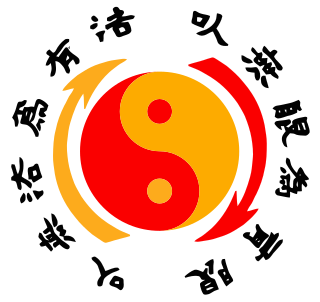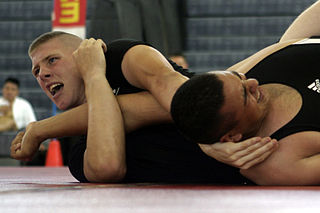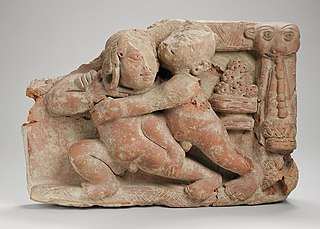
Grappling is a fighting technique as well as a full-contact combat sport based on throws, trips, sweeps, clinch fighting, ground fighting and submission holds.

Judo is an unarmed modern Japanese martial art, Olympic sport, and the most prominent form of jacket wrestling competed internationally. Judo was created in 1882 by Kanō Jigorō as an eclectic martial art, distinguishing itself from its predecessors due to an emphasis on "randori" instead of "kata" alongside its removal of striking and weapon training elements. Judo rose to prominence for its dominance over established jujutsu schools in tournaments hosted by the Tokyo Metropolitan Police Department, resulting in its adoption as the department's primary martial art. A judo practitioner is called a "judoka", and the judo uniform is called "judogi".
Martial arts are codified systems and traditions of combat practiced for a number of reasons such as self-defense; military and law enforcement applications; competition; physical, mental, and spiritual development; entertainment; and the preservation of a nation's intangible cultural heritage.

Professional wrestling is an athletic form of theater that revolves around mock combat performed in a squared ring. The storylines are typically based around interpersonal conflicts between good-natured "faces" and villainous "heels". While the ring is the main stage, additional scenes may be recorded for television in the backstage areas of the venue, in a format similar to reality television.

Jeet Kune Do is a hybrid martial art conceived and practiced by martial artist Bruce Lee. It was formed from Lee's experiences in unarmed fighting and self-defense—as well as eclectic, Zen Buddhist and Taoist philosophies—as a new school of martial arts thought.

Glima is the name that covers several types of Nordic folk wrestling practiced as sport and combat. In one common form of glima, players grip their opponent by the waist and attempt to throw them to the ground using technique rather than force. Other variants allow for more aggression.

Japanese martial arts refers to the variety of martial arts native to the country of Japan. At least three Japanese terms are used interchangeably with the English phrase Japanese martial arts.

Submission wrestling, also known as submission grappling, submission fighting or simply grappling, is a competitive martial art and combat sport that focuses on ground fighting and submission techniques. It is a hybrid discipline that incorporates elements of various grappling arts, mostly Brazilian jiu-jitsu but also Judo, Sambo, and wrestling. Submission wrestling is practiced both as a competitive sport and as a training method for self-defence and mixed martial arts (MMA).

Wrestling is a martial art and combat sport that involves grappling with an opponent and striving to obtain a position of advantage through different throws or techniques, within a given ruleset. Wrestling involves different grappling-type techniques such as clinch fighting, throws and takedowns, joint locks, pins, and other grappling holds. Many different wrestling techniques have been incorporated into martial arts, combat sports, and military systems. Wrestling can either be genuine competition or athletic theater.

Ssireum or Korean wrestling is a folk wrestling style and traditional national sport of Korea that began in the fourth century.

Sambo usually pronounced as (samba) is a martial art with Soviet origins, an internationally practiced combat sport, and a recognized style of amateur wrestling included by UWW in the World Wrestling Championships along with Greco-Roman wrestling and freestyle wrestling.
Indian martial arts refers to the fighting systems of the Indian subcontinent. A variety of terms are used for the English phrases "Indian martial arts", deriving from ancient sources. While they may seem to imply specific disciplines, by Classical times they were used generically for all fighting systems.

A folk wrestling style is any traditional style of wrestling, which may or may not be codified as a modern sport. Most cultures have developed regional forms of grappling.

Collar-and-elbow wrestling is a style of jacket wrestling native to Ireland. Historically it has also been practised in regions of the world with large Irish diaspora populations, such as the United States and Australia.

Malla-yuddha is the traditional form of combat-wrestling originating in India. It is closely related to Southeast Asian wrestling styles such as naban and is one of the two ancestors of kushti. Indian wrestling is described in the 13th century Malla Purana.

Although the earliest evidence of martial arts goes back millennia, the true roots are difficult to reconstruct. Inherent patterns of human aggression which inspire practice of mock combat and optimization of serious close combat as cultural universals are doubtlessly inherited from the pre-human stage and were made into an "art" from the earliest emergence of that concept. Indeed, many universals of martial art are fixed by the specifics of human physiology and not dependent on a specific tradition or era.

Jujutsu, also known as jiu-jitsu and ju-jitsu, is a family of Japanese martial arts and a system of close combat that can be used in a defensive or offensive manner to kill or subdue one or more weaponless or armed and armored opponents. Jiu-jitsu dates back to the 1530s and was coined by Hisamori Tenenouchi when he officially established the first jiu-jitsu school in Japan. This form of martial arts uses few or no weapons at all and includes strikes, throws, holds, and paralyzing attacks against the enemy. Jujutsu developed from the warrior class around the 17th century in Japan. It was designed to supplement the swordsmanship of a warrior during combat. A subset of techniques from certain styles of jujutsu were used to develop many modern martial arts and combat sports, such as judo, aikido, sambo, ARB, Brazilian jiu-jitsu, and mixed martial arts. The history of the art during this time is uncertain because teachers kept everything secret to give their art a feeling of importance and then would change the stories of their art to suit their own needs.

Anatoly Arkadyevich Kharlampiyev, was a Russian researcher of various kinds of national wrestling and martial arts, Merited Master of Sports of the USSR, and Honored Coach of Sports of the USSR. He was one of the founders of Sambo, a martial art technique developed in the Soviet Union. Kharlampiyev worked as a physical education trainer at the Communist University of the Toilers of the East, and also was a student of boxing, fencing, acrobatics, and mountaineering. In 1938, Kharlampiyev presented Sambo to the USSR All-Union Sports Committee, which recognized the martial art as an official sport.
The traditional martial arts of the Mainland Southeast Asia are related to one another, and as a group to Indian martial arts. The most salient common feature is Mainland Southeast Asia kickboxing. The region of Mainland Southeast Asia is believed to be the land of Suvarnabhumi that ancient Indians mentioned in Buddhist text and Hindu text. In 790 A.D., a Khmer prince who grew up abroad by the name of Jayavarman II returned to unify the Khmer civilization. In 802 A.D., Jayavarman II established the Khmer Empire, the precursor to modern Cambodia, and declared himself the Chakravatin. Around 850 A.D., Pagan, the ancestor of modern-day Burma, was established by Tibeto-Burman speakers. For 200 years, Pagan remained a small principality until the reign of King Anawrahta. In 1238 A.D., Thailand's first state, Sukhothai, was started when the residents declared independence from the Khmer Empire. In 1353 A.D., Laos's first state, Lan Xang, was started by Fa Ngum with the assistance of the Khmer from Angkor.
Khong kangjei, also known as foot hockey, Manipuri hockey or hockey on foot, is a sport similar to field hockey primarily of the state of Manipur in India. It is a game which requires stamina, speed, and agility, and is one of the most popular games in Manipur. It is one of the indigenous sports of Manipur, others being sagol kanjei and kang, each of which reflects the martial tradition of Manipur, and with mukna captures an ethical code important to the culture of Manipur.

















